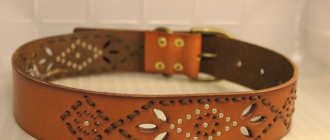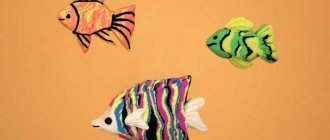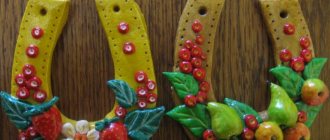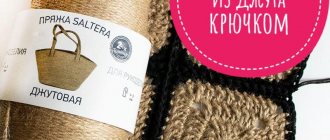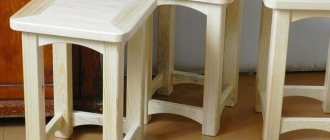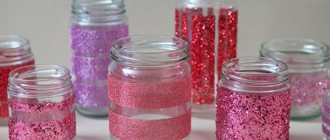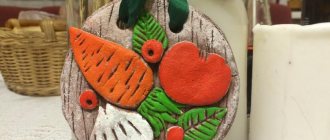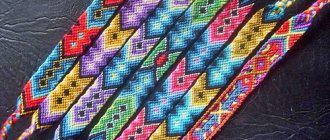As it turns out, making a collar for a dog with your own hands is not at all difficult if you know the basic principle of assembling all the parts. You will only need to find the necessary accessories and an original ribbon that will serve as the basis of the collar.
I usually buy beautiful turnip tape and fasteners from Aliexpress because... You can rarely find something suitable in our stores. Please take a look, maybe you’ll find cool spare parts for the collar to work with: ribbon, clasp, slider buckle, half ring.
And now, I bring to your attention step-by-step instructions for making the most important accessory for your four-legged friend. You will learn how to sew a collar from nylon webbing.
What materials will you need?
Before starting work, you should look at pictures of a dog collar and choose a reference. That is, an approximate version of the product that should be obtained as a result. In some cases, you can get by with old things that have long gone out of use. You will need:
- Worn bags;
- Belts and sashes;
- Items made of dense fabrics (leather, velor, denim, bolognese, fiberglass, tapestry);
- Accessories and decorations (beads, stones, sequins, rivets);
- Reflective tape (fabric);
- Thick or thin nylon clothesline;
- Black or colored electrical tape (preferably matching the color of the future accessory);
- Strong threads, gypsy needle or awl;
- Glue “moment” or its equivalent;
- Indelible marker;
- Metal ring (diameter should be equal to the width of the collar).
Before you make a dog collar with your own hands, make sure you have all the necessary components. It is not necessary to look for all the listed items, but to make a complete and functional product you must have:
- Material for the base (canvas, fabric for a collar or rope for a noose or braided version);
- Accessories for fastening (buckle from an old belt, or fastex from an old backpack or waist bag).
- Sewing supplies.
You can also decorate the product with embroidery, applique, stripes, etc. At the same time, decoration can carry a certain functionality. For example, you can embroider the pet's name or the owner's phone number on the collar so that if the animal is lost, you can easily contact him.
For those who like to walk in the evenings, a reflective tape will be an excellent decoration, which will help you see the dog better in the dark.
How to use it correctly?
On the address book you must write down all the information that will allow you to return your lost pet home. Usually all inscriptions are applied on both sides.
- On one side they indicate the name of the dog, and along with it the phone number of the owners. The address is rarely included because it may end up in the hands of people associated with crime. Not every person agrees to risk their safety like that.
- On the back of the token or tag, you can indicate special additional information, for example, that the pet is a guide dog or suffers from some kind of illness or needs treatment. Sometimes owners use a trick and specifically indicate on the address book that their pet is seriously ill with something, so that no one wants to keep the dog without returning it to the breeder. However, such information can also play a bad joke on the four-legged dog - people may be afraid to contact him because of his illness.
Often the address cards contain information that allows other people to immediately understand that the pet is lost. In such cases, the owners prefer to write:
- “Call the owner!”;
- “Bring me home!”;
- "I want to go home!";
- “I’m lost (or lost)!”
To apply an inscription, you can turn to engraving. For this purpose, special automatic equipment is used. It acts on the part with a special diamond tip, which removes the top layer from the token, leaving very thin and neat grooves.
Much here depends on the material from which the selected address card is made. Typically, engraving is used when the product is made of metal. The softer this material is, the deeper and more noticeable the furrow will end up.
There is also a laser engraving method. In accordance with it, the top layer is also removed. Here you can apply larger and wider symbols. This method of applying text to a token is considered optimal because it gives good results and does not take up a lot of free time.
The prepared address card with all the information printed on it must be correctly and firmly attached to the collar of your four-legged friend. For fastening, it is recommended to use high-quality and tight rings with a cross-section of at least 1 mm or special carbines designed for such elements. The latter are very convenient at moments when you need to remove the address card in order to wash the collar or change it to another one.
If the sound of the token irritates you, you can use a remedy such as anti-ringing. It is made from soft silicone rubber. It fits tightly to the surface of the token, as if hugging it. As a result, the sounds that the addressee makes are inevitably absorbed, and the person stops hearing them. Anti-ringers can glow in the dark.
Reliability, functionality and safety
The primary question in the process of making ammunition for an animal is: how to sew a collar for a dog with your own hands so that it is not only beautiful, but also durable. In this case, it is important to focus on such parameters as the size, speed, character of the pet and, importantly, preferred walking areas.
So, for small dogs that are not prone to running away, a decorative collar-ornament is suitable; for pets who pull, it should be tight, well fixed with a reliable clasp. For medium-sized and giants, it is desirable to have good quality ammunition that will not let you down in any situation.
It should be taken into account that if the dog often goes to the beach and loves to swim, a leather collar will not suit him (it stretches and deteriorates from frequent exposure to water), and a metal clasp is not advisable, since after a couple of swims it will become rusty or oxidized. When the dog often walks on sand or clay soil, the accessory on the neck will be constantly smeared, grains of sand will get clogged into the porous fabric.
If your dog is friendly and likes to play with his friends, you should think about the safety of both parties. Dogs love to bite each other's necks when playing, so the ideal option would be a wide collar made of very dense material, while avoiding decorations in the form of thorns and glued-on stones.
Firstly, such details can damage your four-legged friend, and secondly, a playmate can accidentally swallow part of the decor and get health problems.
Required Tools
When the issue of manufacturing material has been decided, pet owners select tools. If you have a sewing machine at home, then the process is greatly simplified - in this case, you only need to choose the right needle and thread corresponding to its thickness.
But you can easily do it without a machine by sewing belts and connecting the parts manually. An awl often comes to the rescue here if it is difficult to pierce a canvas or leather tape with a needle. Without fasteners and double-slot buckles, a finished finished product will not work - accessories (plastic or metal) must be purchased in advance.
How to measure a dog for a collar
Comfort for you and your dog
Before choosing a specific accessory design, you should also think about how convenient it will be to use. To do this, you need to understand a few cynological tricks:
Note!
DIY ottoman: TOP-190 photos of the best diagrams and drawings. Do-it-yourself master class with a full description of the stages of work
- Do-it-yourself easel - varieties, drawings with dimensions for creating with your own hands. Step-by-step instructions for beginners
- How to Write a Screenplay: Tips and Best Practices for Writing a Screenplay. Step-by-step master classes for beginners with detailed descriptions of the stages
- To make it easier to control the dog, the collar should be attached immediately behind the ears; the lower it slides during use, the more difficult it is for the owner;
- If your pet is pulling, you should under no circumstances lead him with a wide collar or, worse, a harness;
- If there are problems with control (the animal pulls, breaks from the leash, zoo aggression is possible), a noose collar for dogs is ideal;
- A good control should not be too soft on your pet's neck, or too wide or too narrow. (Thin choke chains are used only for canine adjustments or preparation for the ring).
Compression controls (choke, semi-choke with clamp) can be used on animals older than 8 months.
How to choose in a store
When buying ammunition for your pet, it is better to take it with you, since choosing a product in absentia is a complex process. Many stores allow you to try on accessories. A good harness should not dangle on the animal. If the accessory is not selected in size, then when moving it will move to the sides or slide down. The best alternative is to purchase a product with adjustable straps. It is not recommended to take tight models, so as not to make it difficult for the animal to breathe.
How to make the right choice
In conclusion, it should be said that all parts must be sewn firmly and efficiently so that the harness does not fail at the dog’s first serious tug. Before putting it on your dog, you need to determine the strength of the product. Belts can be made on rings to adjust their length.
*Prices are valid for January 2022*
Measuring the dog
If the collar is sewn for a puppy, it is advisable to take into account the growth factor, that is, the possibility of adjusting the strap. You need to measure the animal's neck by placing a tape measure under the jaw and placing it behind the ears, close to the body. This is the place where the collar is fixed, that is, where the buckle or parts of the flexibles meet. If a fastener is not intended, then the length should correspond to the circumference of the head (including ears).
In the case of breeds where the coverage of the neck and head is practically the same, you need to measure the dog under the front armpits (this size will allow you to attach a safety strap to the collar so that the dog does not fly out of it).
Sew a collar
The easiest way to consider this process is step by step:
Taking into account the parameters of the dog, you need to make a cut of material (fabric). It should be equal to the width of the intended product, multiplied by 3. If the collar is 4 cm wide, the cutting width should be 12 cm. The length should also be taken with a margin, depending on the type of clasp chosen. To secure the flexiblex you need at least 2 extra cm at each end. For a mechanism with a buckle, you need to leave 2 cm to secure the plaque and a small tail with 1-2 additional holes.
The resulting cut must be folded in three widths and ironed. You will end up with one edge folded, and the other raw edge lying on top. If the fabric is not fleecy, you can leave the edge in its original form; if threads stick out from it, it is better to burn them. The folded piece of fabric must be basted along each edge, and then sewn with a stitch. After this, all that remains is to put on the flexiblex or buckle. If you need to make holes, you need to make them with a hot awl, otherwise they will quickly fray. You can decorate the product at your discretion.
Note!
- DIY medical mask: TOP-140 photos of the best DIY options. Instructions for making a mask at home
How to make a piggy bank with your own hands - the best ways to make a piggy bank with your own hands. Detailed master class for beginners with photos and videos
Cold porcelain: features and methods of making it at home. Reviews of the best recipes + 120 photos
It is convenient when the leash clings not to the collar, but to a special ring. You can find it on old bags, use a link from a chain, or buy it at a hardware store. At the same time, it is important to secure it so that the ring does not travel along the entire length of the collar. To do this, you need to put the ring on the collar, right in the middle. In this place, on the reverse side (which is adjacent to the animal’s body), make a patch for this ring, thus securing it completely.
Soft fabric collar
If your pet faces a long recovery period, it is best to get a soft protective collar. It is very easy to sew, and it will be much more comfortable for a cat or dog. This design does not interfere with sleep and does not rub the neck. It is very easy to fasten and can be washed easily.
It is better to make such a collar for a cat or dog from durable but hygroscopic fabric. Linen or thick cotton will do. To ensure that the “funnel” keeps its shape and protects well, you can use felt, non-woven fabric, or rigid mesh as a sealant. It is best to make a two-layer or even three-layer version. The protective collar with Velcro fastening is very convenient. You can put it on and take it off literally in one movement, but the animal will not be able to do this on its own.
To make a fabric collar, the pattern is made in exactly the same way as in the previous version. Two parts are cut out of the fabric and another one is cut out from thick felt or non-woven fabric. It is inserted inside to ensure structural rigidity.
The parts of the collar are sewn together, and the edges are finished using bias tape. The fastener can be made by sewing Velcro along the short sides. To provide additional fixation on the pet’s neck, you can stretch a cord along the inside or make loops into which the collar will be threaded, or you can leave it like that.
The simplest option
The easiest way to make a collar is from a belt, because the main components are already ready. However, a dog's sparse neck can rival a human's waist. All you need to do is cut the belt to the required size and make new holes. For ease of use, it is also advisable to leave clamps for the free end and make a patch for the ring, to which the leash will eventually cling.
If the edge of the belt cut is not neat, it is advisable to decorate it. This can be done by treating it with metal rivets or stitching it with leather. The easiest way is to cover it with colored tape and carefully touch it with a lighter. If the belt is made of not very high-quality leather substitute, it can be strengthened. To do this, you need to glue a thick fabric tape on the inside with waterproof (shoe) glue. This trick will not only extend the life of the collar, but also make it more comfortable to wear.
Where to begin?
First of all, you need to decide on the right size. To do this, take an ordinary tailor's meter, measure the diameter of the dog's neck and be sure to write down the result on a piece of paper so as not to “go astray” by mistake. To the resulting figure, add a couple of centimeters for seams and fasteners. The main thing is that the dog collar should not fit tightly. You can use the “sample” of the old collar to guide you.
Tips for beginners
As decoration, you can use beautiful fabric, multi-colored paper bows, bright buttons, a sling made of elastic bands or beads - here you are free to use your imagination as you wish. To dress up your beloved pet, you need to decide for what purpose the collar and leash will be used. By area of application, the following types are distinguished:
- Walking is the most popular version of “ammunition”, which is additionally equipped with a half-ring to quickly fasten a leash for a dog, and can be equipped with LED lighting.
- Training – special “ties” for pets, which have a comfortable handle to hold the animal during training.
- A guard collar is a high-strength collar, which is usually made of a belt or thick leather.
- Choke - usually used to present a pet at exhibitions and can be made of different materials (synthetics, leather or metal chain).
Particularly popular today is a luminous pet collar, which is simply indispensable for evening walks. If the dog lags behind or runs far ahead, you will always see the place of its “dislocation”. Such a collar is also a warning to random passers-by, because it can be noticed from afar. Are you interested in how to make a glowing collar? At the moment, with the development of LED technology, it is easier to purchase it ready-made, for example, on AliExpress.
Wicker options
You can weave a dog collar from a number of available materials. For this you can use:
- Fabric scraps;
- Old belts;
- Clothesline or nylon rope.
In addition to the above, you will need to take care of the clasp. This can be a flexiblex or a noose-type mechanism or a semi-noose type mechanism. For a noose, 2 identical metal rings are required, for a semi noose, 3 rings and a chain.
Note!
- Cake decorating: TOP-170 photos of the best ideas for decorating a cake at home + instructions for beginners with simple patterns
How to make a house out of cardboard: 140 best photos of children's crafts with your own hands + step-by-step manufacturing instructions with simple diagrams
- DIY rose lamp - step-by-step instructions for creating a lamp with your own hands + original design ideas with photo reviews
Step-by-step weaving of a collar
- Divide the ropes into 3 parts;
- Pass each one through the ring so that 6 equal threads are formed;
- Start braiding your hair;
- When you reach the desired length, pull the ends of the ropes through the second ring in the same way;
- Carefully tie the ropes in a knot;
- Trim off the excess, leaving 3 cm for twisting;
- The remaining ends need to be hidden in the body of the pigtail and stitched with thread;
- To make a full-fledged collar, thread the pigtail through one of the rings to create a noose mechanism.
In the case of Flexex, the collar will not be adjustable. If you pass a chain through two rings and secure it with a third ring, you will get a semi-noose.
Choke collar and leash
This option will be the simplest and most cost-effective. If you have a long rope, you can make a noose leash. In essence, a noose differs from a regular loop in the presence of a lock that prevents the collar from slipping and stretching.
For production you will need:
- A rope (length depends on the desired result) for a noose collar is enough +10 cm to the circumference of the head; for a comfortable leash, 2-2.5 m is required.
- Electrical tape in the color of the rope;
- Needle and thread;
- 1 metal ring;
- 1 clamp (preferably metal).
Execution:
- Place the clamp on the rope;
- At one end, form a handle (for a leash) or a 2-3 cm loop for a carabiner in the case of a collar;
- Sew it with threads, secure with electrical tape and secure with a lighter;
- Place a ring on the other end, also sew and secure;
- Thread the rope through the ring, the resulting loop, put it on the dog’s head using a clamp to secure the position of the collar behind the ears.
Making a collar for your pet with your own hands at home from available materials is quite simple, the main thing is to show imagination and perseverance.
It is also important to understand that accessories for animals must be safe for themselves and for others, so special attention should be paid to the quality of materials and the strength of connections.
